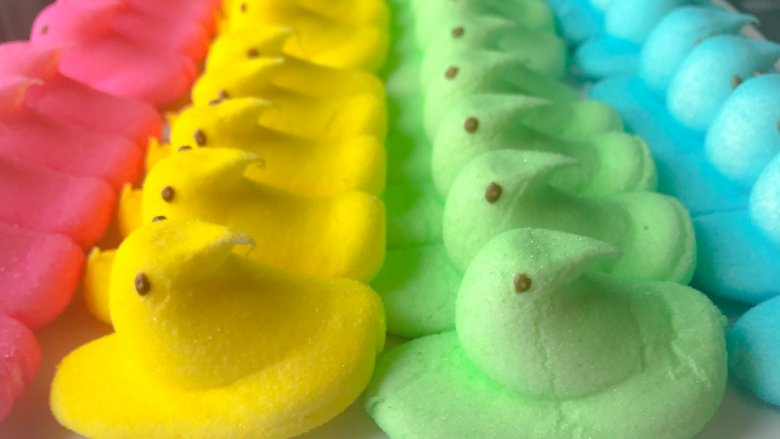Microwave A Peep, And Watch What Happens
People love themselves some Peeps when Easter rolls around. It's no surprise that millions of the marshmallow treats are churned out ever year and have been since 1953. As much as people enjoy eating Peeps — even in particularly strange ways, like on pizza — destroying them is equally good fun. If you can bear to part with a few of your Peeps, may we make a suggestion? Throw those sugary chicks into the microwave and set that sucker to stun! (Actually, Wired recommends low to medium heat for about 20 seconds.)
Once in the microwave, you'll notice pretty quickly that those Peeps will begin to balloon in size. When the Los Angeles Times conducted a Peep-destroying test, the marshmallow candies grew to around four times their normal size. (Oh, and make sure you use a microwave safe plate to avoid disaster.) Just as quickly as those marshmallow candies expand, they deflate into just a gooey mess of their former selves.
If you're the curious type who can't help but wonder why Peeps grow in size until nearly exploding in the microwave, well, it's all about gases. Contrary to what the Easter Bunny may have told you as a child, Peeps don't grow on trees but are made in a factory out of sugar, corn syrup, and gelatin. This mixture is melded together to create air bubbles that help the Peeps keep their spongy texture and distinct shape (via Decoding Delicious). The powerful zap of heat from your microwave throws that marshmallow mixture into chaos and makes the water molecules in the corn syrup rapidly heat up. When those water molecules turn to steam they cause the air bubbles to expand, which causes the Peep to basically Hulk out.
There's more than simply rapid growth going on with your Peeps when they're locked away in the microwave. That blast of energy heats the marshmallow from the inside and as the sugars exceed a temperature of 300 degrees Fahrenheit, they'll also begin to caramelize and brown — from the inside. This only happens with the standard gelatin-based peeps, however, and if you're using the vegan variety you won't see any browning of the marshmallow. You'll probably also notice that your Peep may smell a little different when you open up the microwave door. The breakdown of the sugars from the heat can give off a somewhat nutty aroma. Mmm, burnt Peeps.
As far as taste, well, let's just say that nobody is going to mistake a Peep that's been put through the ringer of the microwave for one fresh out of the cellophane. Sure, it will probably still have a sugary taste, but's also likely to be a lot chewier and possibly even crunchy — depending on how long you microwaved it. This is because the Peep has lost all of the moisture once the water molecules were essentially sucked out of it. One thing is certain, though — that inflated and subsequently deflated Peep is going to be very, very hot, so watch the tongue.
Of course, the microwave isn't the only way to destroy, er, we mean "creatively enjoy" your Peeps. People on social media have turned the marshmallow Peep into a sort of Easter lab rat by finding all kinds of creative ways to experiment with them. Besides the microwave method, there's the old-fashioned campfire approach, tossing them in the blender, or tying them to a bundle of bottle rockets. No wonder #DeathToPeeps and #PeepsMassacre actually exist as Instagram hashtags.
For those of you who opt to roast your Peep over a campfire (Peep s'mores are way more fun than regular s'mores, right?) rather than take the microwave approach, you'll notice that your Peep doesn't expand nearly as much or as quickly, but instead just browns. (Unless you're the type to just shove their poor Peep directly in the flame.) According to The Verge, this is primarily because an open flame is going to be giving off more direct heat and unlike the microwave, your Peep is being heated up on the outside, rather than the inside.
At the end of the day, whether you decide to microwave your Peeps or just eat them as the Easter Bunny intended, it's easy to see why people flip over this sugary treat.
